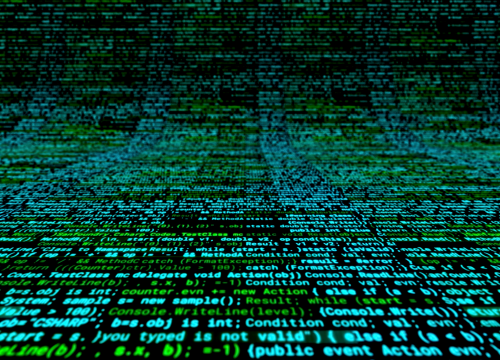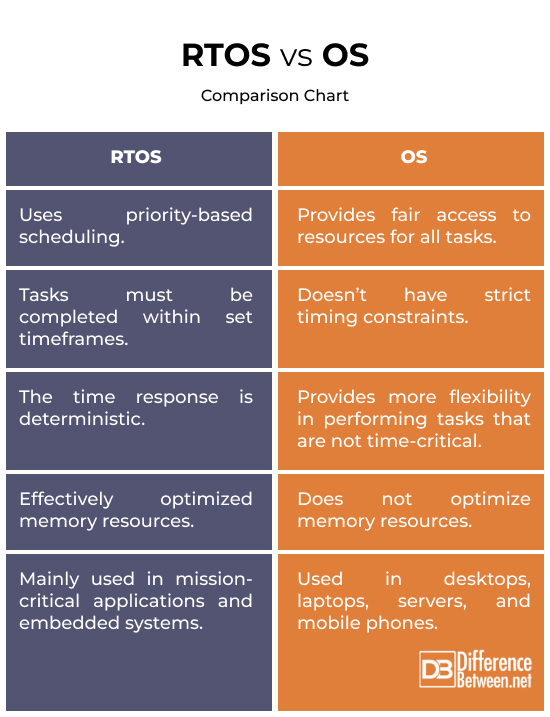Difference Between RTOS and OS
In what ways is a general-purpose operating system (OS) distinct from a real-time operating system (RTOS), and what are the fundamental differences between the two? These are the questions that will be addressed in this post that is full with information. They are both operating systems, but real-time operating systems are built for circumstances in which timing is of the utmost importance. It has been tuned for applications that demand instantaneous responses to events that occur in the outside world.
To begin, we will provide an outline of what an operating system (OS) is and how it varies from a normal operating system (OS). In addition to that, we will discuss the components that make up an RTOS structure.

What is an RTOS?
An operating system dedicated to real-time computing applications is referred to as an RTOS. Imagine working in a system where instantaneous choices are of the utmost importance and tasks are subject to stringent time limits. As its name suggests, a real-time operating system is able to switch between activities in a matter of seconds, so ensuring that crucial actions are carried out precisely when they are required to be.
There are three primary types of real-time operating systems (RTOS):
Hard RTOS: When it comes to hard real-time operating systems, these systems are subject to stringent deadlines that must be reached without fail, and failure is not an option. Medical devices, aviation control systems, industrial process controllers, and other various types of controllers are some examples.
Soft RTOS: In soft real-time operating systems, it is permissible for there to be some fluctuations in timing. It is possible that missing deadlines will not result in grave consequences. Streaming services, gaming systems, and other such examples are examples.
Firm RTOS: Firm real-time operating systems are a hybrid of hard and soft systems. However, there are not usually serious repercussions associated with missing deadlines. Systems for trading stocks, robotics, and other examples are examples.
Real-time operating systems such as FreeRTOS, VxWorks, Linux Foundation Zephyr, and ThreadX are among the most notable examples of such systems.

What is an OS?
An operating system, sometimes known as an OS, is a collection of software that is responsible for managing the flow of information and resources between all of the many programs and hardware components that are present in a computer. On a computer, it is the most important piece of software that is currently running.
The inability to run programs, communicate with hardware, or properly manage files is a consequence of not having an operating system installed on your computer.
Key functions of an OS include:
- Resource management: It allocates resources like memory, CPU time, and storage space efficiently among different programs running on the system.
- Memory management: It decides which process will get how much memory at what time.
- Process management: It handles multiple processes at once and determines the order in which programs are executed.
- File management:It keeps track of where files are stored. It allows you to create, modify, and delete them.
- Device management: It facilitates communication with peripheral devices such as printers, keyboards, and storage devices.
- Security: It protects your system from unauthorized access.
- User Interface: It provides a user-friendly interface for interaction, whether through a command-line interface (CLI) or a graphical user interface (GUI).
Difference between RTOS and OS
Time Constraints
An RTOS is an operating system for real-time computing applications where tasks must be completed within set timeframes. Failure is typically not an option in such systems. A general-purpose OS focuses on general-purpose functionality without any strict timing constraints. However, some tasks may have stringent time constraints.
Priority
RTOSs prioritize tasks based on urgency. The scheduler ensures that high-priority actions are executed immediately. A real-time operating system provides a deterministic environment where tasks run exactly as planned. In an OS, the priority of tasks is not as critical, and the scheduler provides fair access to resources for all tasks.
Behavior
The time response of a real-time operating system is deterministic. It rapidly switches between tasks to ensure critical actions happen exactly when they need to. A general-purpose OS, on the other hand, provides more flexibility in performing tasks that are not time-critical.
Applications
An RTOS is commonly used in embedded systems, real-time control systems, defense systems like RADAR, air traffic control systems, command control systems, telephone switching equipment, and more. A general-purpose OS is used in general-purpose computing environments such as desktops, laptops, and servers.
RTOS vs. OS: Comparison Chart

Summary
For this reason, a real-time system can be defined as any system that is capable of providing a deterministic response to a specific process or activity. Any system that fails to meet deadlines must be real-time in order for it to be considered successful. However, it is essential to be aware that the real-time needs for systems might vary greatly from one system to another. The finest element is that the jobs that deal with time constraints can be finished first in order to get the results that are sought. A general-purpose operating system, on the other hand, is intended to carry out activities that do not require a significant amount of time to complete.
FAQs
How is RTOS different from OS?
RTOS prioritizes quick and deterministic responses to external events. It prioritizes time-sensitive tasks over low-priority ones. A general-purpose OS, on the other hand, doesn’t prioritize time-critical tasks.
What is the difference between real-time and embedded operating systems?
RTOS ensures tasks are completed within strict deadlines, no matter what. Embedded operating systems prioritize efficient use of resources to keep the system running smoothly.
What is the difference between real-time and network operating system?
Real-time operating systems are often used in applications where response times are critical. Network operating systems, on the other hand, are designed to manage network resources and facilitate communication between computers in a network.
Is Windows OS a RTOS?
No, the Windows OS is not a real-time operating system.
Is Linux a RTOS?
No, Linux is not inherently a real-time operating system. However, there are real-time variants of the Linux kernel, such as PREEMPT-RT and the Xenomai project, which provide real-time capabilities on the Linux platform.
What are the disadvantages of RTOS?
Some disadvantages of RTOS include:
- Increased complexity
- Complex algorithms and programs
- Limited multitasking
- Expensive hardware
- Limited device drivers
Which OS is RTOS?
Examples of real-time operating systems include FreeRTOS, VxWorks, QNX, and RTLinux.
Is Android a real-time operating system?
No, Android is not a real-time operating system.
Is RTOS a programming language?
No, it’s not a programming language but a type of OS that prioritizes time-critical tasks.
- Difference Between Caucus and Primary - June 18, 2024
- Difference Between PPO and POS - May 30, 2024
- Difference Between RFID and NFC - May 28, 2024
Search DifferenceBetween.net :
Leave a Response
References :
[0]Amos, Brian. Hands-On RTOS with Microcontrollers. Packt Publishing, 2020.
[1]Li, Qing and Caroline Yao. Real-Time Concepts for Embedded Systems. CRC Press, 2003.
[2]Wang, K.C. Embedded and Real-Time Operating Systems. Springer, 2017.
[3]Image credit: https://www.canva.com/photos/MADBhw9KzJA-operating-system-word-cloud/
[4]Image credit: https://www.canva.com/photos/MAE2kFEFJ7E-futuristic-computer-code-programming-curving-screen-with-colorful-lines-on-black-background-animation-scrolling-through-code-program-bending-digital-texture-/
